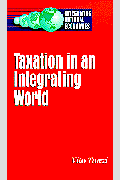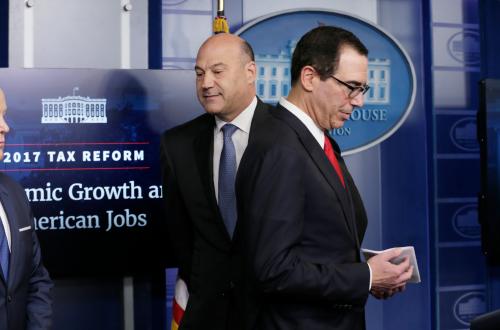Efforts to improve the competitiveness of U.S. companies often focus on how we tax U.S. companies on the income they earn in foreign markets. For example, calls for a lower corporate rate and a territorial tax system, in which income earned by U.S. companies in foreign markets is excluded from U.S. tax, are often motivated by a desire to boost exports or the worldwide share of income earned by American companies.
But that focus has overshadowed a more important—and simpler to solve—problem of how to improve the competitiveness of U.S. businesses in our own market by limiting the substantial tax advantage we offer foreign-owned companies right here in the U.S. There should be broad agreement not to give tax advantages in our domestic market to companies whose headquarters and factories are abroad in Europe, Asia or a Caribbean tax haven. That’s why the decision by the Trump administration to revisit and delay components of Treasury’s “385” earnings-stripping regulations is hard to fathom. Without the regulations, American-owned businesses will be worse off.
The regulations targeted a major tax advantage foreign competitors have over U.S. businesses in our home market: the ability to avoid U.S. corporate taxes via interest stripping. U.S. and foreign-owned companies are supposed to pay the same rate of tax from income earned in the U.S. But in an interest stripping transaction, a foreign company loads up its U.S. subsidiary with debts owed to its foreign parent or, more often, a shell company established in a tax haven. The interest paid by the U.S. subsidiary is deductible against U.S. taxable income, but the tax haven country doesn’t tax the interest received. By cranking up purported interest payments, a company can drive its U.S. tax base to zero while still keeping all of the profits within the larger company.
Without the regulations, American-owned businesses will be worse off.
Purely domestic U.S. firms can’t engage in such activities, and U.S. multinationals pay tax on passive income, like interest received, whether earned in the U.S. or in the Cayman Islands, so the scope of avoidance from U.S. companies is much smaller. Unlike other problems of the corporate tax, the disadvantage that U.S. firms face is not about whether U.S firms are taxed on business income earned abroad, nor is it the result of the U.S. rate, which applies equally to domestic and foreign firms on their U.S. activities—even at a lower corporate rate, American companies would remain at a disadvantage.
The practical result of interest stripping is that a U.S. company operating on one street corner—a retailer, grocer, consulting firm, manufacturer—pays full-freight 35 percent tax on the profits it earns while the company across the street vying for the same customers may pay nothing. The result is that the foreign-owned firm can underprice or outspend its U.S. competitor to expand its operations or bring in more clients. The headquarters and production jobs that support that expanded market share are more likely to be overseas.
The tax advantage is so large that interest stripping is the primary reason why companies invert or relocate their residence overseas, and it fuels foreign acquisitions of U.S. businesses. In effect, we pay foreign investors to take over our companies with our own tax dollars. The day after an inversion, the U.S. company is loaded with related-party debt, driving down its taxable income. Months or years later, however, the real costs of the transfer to foreign ownership may be even larger: less investment in U.S. operations, the U.S. workforce, or the local community.
Enter the 385 regulations, named for the relevant section of the tax code. The rules targeted fabricated financial transactions between parents and subsidiaries intended to produce interest deductions, limiting the ability to strip interest and the incentives to invert. They helped level the playing field between U.S.- and foreign-owned competitors and reduced the primary incentive for U.S. companies invert and move their headquarters and key operations abroad. The Treasury estimated the rule would stop about $7.4 billion of tax avoidance over the next decade, much of it from inverted companies.
While the rule was even handed and applied to issues of avoidance by both domestic and foreign firms, the big dollars come from foreign owned firms because interest deducted against U.S. taxable income is generally paid to corporations in tax havens—where it’s never subject to tax. The rules were narrowly targeted to the cases where tax arbitrage was most likely and costliest. Only 1,200 taxpayers—the very largest multinational corporations—would be affected by the limitations on interest deductibility.
Furthermore, the rules make sure that the limits would not impair new investment in the U.S. Financing activities associated with new domestic investment are carved out. For instance, interest paid on new borrowing used to make a new investment in the U.S. would continue to be deductible.
Eliminating interest stripping and inversions is a bipartisan objective, advanced not just by the prior Administration’s regulations but also in the major corporate tax reforms like the one crafted by former House Ways and Means Chairman Camp and the border adjustment tax (BAT) promoted by his successor Chairman Brady.
Someday we will renovate our business tax code to remove the incentives and ability for corporations to dodge U.S. taxes, but until we do, the 385 regulations are essential.
The Brookings Institution is committed to quality, independence, and impact.
We are supported by a diverse array of funders. In line with our values and policies, each Brookings publication represents the sole views of its author(s).









Commentary
The 385 tax rules make American businesses more competitive—Treasury should keep them
August 10, 2017